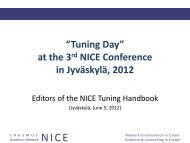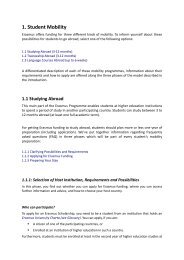5. As social systems developers and interveners, CGC practitioners change organizationsand communities. As change agents, they should be able to facilitate such conditionsunder which people can identify and develop their sustainable talents. They removeobstacles on the labour market and within organizations so serendipity can happen.Changes are directed to more opportunities, new experiences, more chance to meet adiversity <strong>of</strong> people and ideas.6. CGC Pr<strong>of</strong>essionals. The serendipic pr<strong>of</strong>essional:◆◆Has faith that clients will come with new solutions, new associations;◆◆Is very patient and calm: s/he creates space for every client or group;◆◆Is able to give structure with a feel for unexpected and accidental occurrences;◆◆Is perspicacious and alert, with the focus on observing;◆◆Has a good feel <strong>of</strong> the ‘wholeness’ <strong>of</strong> an individual, group or organization;◆◆Has a good feel for the ‘flow’ <strong>of</strong> our society;◆◆◆◆◆◆◆◆Has a good feel for hidden sustainable talents <strong>of</strong> individuals and groups and theorganisations’ hidden sustainable strengths;Has insight in talent development and serendipity;Is able to let serendipity do ‘the work’, not pushing and diagnosing;Stimulates ‘group wisdom’, amplifies the solution power <strong>of</strong> a group/organisation.Impact on the Content <strong>of</strong> CGC Training ProgrammesSerendipity will have an important impact on the content <strong>of</strong> our <strong>training</strong> programmes. FirstCGC practitioners need knowledge <strong>of</strong> theories and research on the concept <strong>of</strong> serendipity.Not only research in the domain <strong>of</strong> career guidance and counselling, but also from severalother perspectives: in scientific discoveries, history, on the internet, in art, in travelling, music,sports, social relations and so on. Second, and <strong>of</strong> similar importance, is knowledge <strong>of</strong> brain researchand possibilities to integrate this knowledge in the <strong>training</strong> and coaching practice itself.In particular, knowledge <strong>of</strong> smart unconsciousness is relevant. In addition CGC practitionersalso need knowledge <strong>of</strong> chaos theory, exploratory behaviour and sustainable talents.The CGC practitioners need to learn the skills, attitudes and sensitivities <strong>of</strong> the serendipic pr<strong>of</strong>essional(see above). First <strong>of</strong> all they have to discover and trust serendipity in their own career.They need a learning environment that trains them to deal with capriciousness, uncertainty,unexpected events and fear. Then they have to learn to make their clients aware <strong>of</strong> serendipityin their life and how they get the “unsearched find”. Finally orientation, calibration, adaptation,allowance <strong>of</strong> sufficient space, and change are the core concepts for <strong>training</strong> the CGC practitionersin the specific pr<strong>of</strong>essional roles.ReferencesAken, T<strong>eu</strong>n van and Wouter Reynaert (2006). The SerendipityGame. Explore your latent talents for work and income,Tilburg, Fontys University HRM and Psychology.<strong>NICE</strong> HandbookExample <strong>of</strong> Innovative PracticeReynaert en Van Aken (2006) designed the “SerendipityGame” to makethe serendipity model <strong>of</strong> career work in practice. They demonstrated and playedthe game at several conferences and studied the effects <strong>of</strong> the game with differentexperimental groups. As the name <strong>of</strong> the game implies, it is all about the unsearchedfind for discovery. The included cards are designed to help clients find and apply theirhidden sustainable talents. These might be talents they need unexpectedly when solvinga problem during one <strong>of</strong> their challenges. There are six variants <strong>of</strong> the game. The gameis focused on an actual ‘emotive’ and triggers the different aspects or dimensions <strong>of</strong>the exploratory drive. The success <strong>of</strong> the game depends on the pr<strong>of</strong>essionalism <strong>of</strong>the game leader. The game leader needs competences and talents that arecritical for creating serendipity for the participants.Dijksterhuis, A. (2004). Think different: The merits <strong>of</strong> unconscious thought in preference development and decisionmaking. Journal <strong>of</strong> Personality and Social Psychology, 87, 586-598.Krumboltz, J.D., & Levin, A.S. (2002). Planned Happenstance: Making the most <strong>of</strong> chance events in your life and yourcareer. Atascadero, CA: Impact.McMahon, M., & Watson, M. (2007).An analytical framework for career research in the post-modern era. InternationalJournal for Educational and Vocational Guidance, 7(3), 169-179.Pryor, Robert and Jim Bright (2011). The chaos theory <strong>of</strong> careers. A new perspective on working in the twenty-firstcentury. London and New York, Routledge.Reynaert, Wouter (red.) (2006). Studieloopbaanbegeleiding en Assessment. Spelen met grondhoudingen. Groningen/Houten, Wolters Noordh<strong>of</strong>f.Trends and Developments164 165
8.6. The Role <strong>of</strong> Prevention ProgrammesLea Ferrari, Laura Nota, Salvatore Soresi and Teresa Maria Sgaramellaworking age report having a long-standing health problem or disability. This condition is associatedwith age, lower educational attainment, being widowed or divorced and excluded fromthe labour market. About 78% <strong>of</strong> people with severe disability are inactive compared to 27%<strong>of</strong> peers without disability.<strong>NICE</strong> HandbookAn increasing number <strong>of</strong> scholars agree that career guidance and counselling needs to expandits interests, theories, assessment tools and practice guidelines to the people that for manyreasons have limited opportunities for self-expression at work and are at risk <strong>of</strong> experiencingan unsatisfactory career development and low quality <strong>of</strong> life (Blustein, 2011). The economicconditions we are experiencing, together with the new challenges characterizing our society,suggest that it is time all CGC researchers and pr<strong>of</strong>essionals to “roll up their sleeves and dotheir part”. Prevention should be considered as being deeply engrained in the philosophy behindthe <strong>NICE</strong> Core Competences (NCC) and the <strong>NICE</strong> Pr<strong>of</strong>essionals Roles. Especially duringactivities focused on <strong>Career</strong> Education, <strong>Career</strong> Information & Assessment, <strong>Career</strong> Counselling,and Social Systems Interventions & Development practitioners can include the seed <strong>of</strong> prevention.Prevention programmes are essential to better prepare all citizens for the actual demands<strong>of</strong> the 21st century workforce and can be viewed from a lifelong learning perspective.Programmes that help people to understand the connection between what they are and whatis expected in the new work <strong>of</strong> world, and which promote career management skills, are essentialto promote lifelong learning, a productive learning environment, and future successfultransitions (Schultheiss, 2005).Groups in Need <strong>of</strong> Preventive ProgrammesWho are the people with significant career and life design needs that challenge the CGC practitioners?Among at risk groups that can benefit from CGC preventive interventions we can list:◆◆Young adultsA recent report <strong>of</strong> the ILO (International Labour Office, 2011) in collaboration with the OECDdepicts a very critical situation. In G20 countries, due to the global economic crisis, from 2000to 2010, the youth employment rate declined dramatically, in some countries between 10-15%(Spain and UK). Compared to adults, the unemployment rate <strong>of</strong> youth is higher, and in somecountries (Italy) it is two to three times more likely. Young adults are also more likely to befound in temporary jobs and positions that <strong>of</strong>fer limited labour market stability, social protectionand opportunities for <strong>training</strong> and career progression. Moreover there is about 10-30%<strong>of</strong> inactive youth that are at risk <strong>of</strong> unemployment, social and economic exclusion. They areknown as youth neither in employment nor in education and <strong>training</strong> (NEET).◆◆Disabled peopleThe European Commission’s report Employment in Europe 2005: Recent trends and prospectshighlights that illness or disability are the second most important reasons for inactivity amongworking age people (25-64 years) after retirement. About 44.6 million (15.7%) <strong>of</strong> people <strong>of</strong>◆◆ImmigrantsFrom the new millennium about three million long-term immigrants enter OECD countries legallyevery year and almost two million do so temporarily (OECD 2011). Migrants escape theircountries’ economic, social and political problems hoping for a better life. Many immigrantsare not given the right to seek an employment, even if they reside in a country legally. Atypicalemployment among immigrants is high and this makes them vulnerable to discrimination andpoverty: below average wages, no social rights, exploitation, etc. The unemployment rates dueto the economic crisis have impacted the foreign workers more strongly than the natives in allOECD countries (OECD 2011).◆◆AdolescentsThe increasingly complex career world and the uncertainty characterizing today’s labour market,are all factors which make young people’s school and career choices very difficult. Loweand Krahn (2000) argue that the ‘negative’ feelings on the few opportunities which the world<strong>of</strong> work reserves for adolescents may become an obstacle to their pr<strong>of</strong>essional development,restricting their future expectations and negatively impacting their career adaptability. <strong>Career</strong>adaptability is defined as the propensity to suitably deal with developmental tasks to getready to and participate in a working role as well as adapt to the unexpected requests due tochanges in the world <strong>of</strong> work and in working conditions (Savickas & Porfeli, 2012). Researchshow adolescents with higher career adaptability perceive lower barriers; have a wider range<strong>of</strong> interests and a higher quality <strong>of</strong> life. Moreover in the last two decades the spending powerand commercial involvement <strong>of</strong> children and young people have increased while social trustand religious commitment have declined in most Western countries. Values more focused onsocial equity, cooperation, environment, self-determination need to be re-discovery and fosteredin order to give career and life new meanings and to increase the perceived quality <strong>of</strong> life(Soresi, Nota & Ferrari, 2012).Types <strong>of</strong> Prevention ProgrammesWhat types <strong>of</strong> preventive intervention programmes can CGC pr<strong>of</strong>essionals devise? Preparingpeople and fostering the skills to design their lives, especially at risk groups, in order to bettercope with the challenges <strong>of</strong> the world <strong>of</strong> work, ensuring individuals can actually enjoy equalopportunities and social equity, and reducing social disadvantages and early discriminationexperiences, is increasingly becoming a priority in the field <strong>of</strong> career guidance and counselling(Soresi, 2011).Trends and Developments166 167






